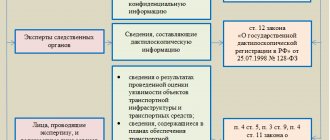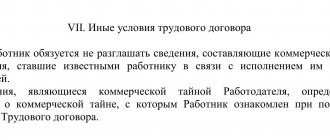CONDITION ON NON-DISCLOSURE OF TRADE SECRETS IN YOUR EMPLOYMENT AGREEMENT
The concept of a trade secret is given in the Federal Law “On Trade Secrets”.
According to Art. 3 of this Law, a trade secret is the confidentiality of information that allows its owner, under existing or possible circumstances, to increase income, avoid unjustified expenses, maintain a position in the market for goods, works, services, or obtain other commercial benefits. Since the content of a trade secret is the confidentiality of information, it is necessary to determine what is considered such information. Information constituting a trade secret is scientific, technical, technological, production, financial, economic or other information (including those constituting production secrets (know-how)), which has actual or potential commercial value due to its unknownness to third parties, to which is not legally accessible and in respect of which the owner of such information has introduced a trade secret regime.
Before including a clause on non-disclosure of trade secrets in an employment contract, the employer must:
- familiarize, against signature, an employee whose access to information constituting a trade secret is necessary for him to perform his job duties, with a list of information constituting a trade secret, the owners of which are the employer and his counterparties;
- familiarize the employee, against signature, with the trade secret regime established by the employer and with the penalties for violating it.
In turn, the employer is obliged to create the necessary conditions for the employee to comply with the established trade secret regime.
The Federal Law “On Trade Secrets” expanded the employee’s obligation to non-disclose information constituting a trade secret. The employee is obliged not to disclose this information not only during the validity of the employment contract, but also after its termination. The duration of such an obligation is determined by a separate agreement between the employee and the employer, concluded during the period of validity of the employment contract. If the specified agreement has not been concluded, then the obligation not to disclose information constituting a trade secret is valid for 3 years after termination of the employment contract.
Maintaining trade secrets is one of the additional conditions of the employment contract.
Currently, the number of such agreements has increased significantly. This is due both to the growth of the competitive environment and to the abolition of the Labor Code of the rule provided for by the Labor Code that an employment contract may contain a condition on non-disclosure of trade secrets only in cases provided for by federal laws and other regulatory legal acts of the Russian Federation. Article 57 of the Labor Code makes it possible to conclude an employment contract with the condition of non-disclosure of information constituting a trade secret with any employee if this information is known to him in connection with the performance of official duties.
What information cannot constitute a trade secret?
When determining the list of information related to a trade secret, one should take into account those contained in Art. 5 of the Federal Law “On Trade Secrets” information that cannot constitute a trade secret. These include information: contained in the constituent documents of a legal entity, documents confirming the fact of making entries about legal entities and individual entrepreneurs in the relevant state registers, documents giving the right to carry out entrepreneurial activities; on the composition of the property of a state or municipal unitary enterprise, state institution and on their use of funds from the corresponding budgets; about environmental pollution, the state of fire safety, the sanitary-epidemiological and radiation situation, food safety and other factors that have a negative impact on ensuring the safe operation of production facilities, the safety of each citizen and the safety of the population as a whole; on the number, composition of employees, the remuneration system, working conditions, including labor protection, indicators of industrial injuries and occupational morbidity, and the availability of vacancies; about the debt of employers in payment of wages and other social benefits; about violations of the legislation of the Russian Federation and facts of prosecution for committing these violations; on the conditions of competitions or auctions for the privatization of state or municipal property; on the size and structure of income of non-profit organizations; on the size and composition of their property, on their expenses, on the number and remuneration of their employees, on the use of gratuitous labor of citizens in the activities of a non-profit organization; on the list of persons who have the right to act without a power of attorney on behalf of a legal entity.
Information, the mandatory disclosure of which or the inadmissibility of restricting access to which is established by other federal laws, cannot also constitute a commercial secret.
Are the employee’s obligations to not disclose trade secrets limited to the duration of the employment contract?
No, not limited. The Federal Law “On Trade Secrets” expanded the employee’s obligation to non-disclose information constituting a trade secret. The employee is obliged not to disclose this information not only during the validity of the employment contract, but also after its termination. The duration of such an obligation is determined by a separate agreement between the employee and the employer, concluded during the period of validity of the employment contract. If the specified agreement has not been concluded, then the obligation not to disclose information constituting a trade secret is valid for 3 years after termination of the employment contract.
A condition on non-disclosure of information constituting a trade secret is included in the employment contract with reference to the list of relevant information with which the employee was familiarized with signature. The wording of this condition is approximately as follows: “Do not disclose information constituting a trade secret, the list of which the employee was familiarized with upon signature.”
Who draws up the document
The commitment is written on behalf of an employee of the company, but, as a rule, its basis is developed
- legal advisers of the enterprise (but there may also be lawyers “from outside”)
- or direct management.
In any case, the specialist drawing up the document form must have the necessary level of knowledge for its competent execution, and must also be familiar with the legislation of the Russian Federation in the field of civil, administrative and labor law. We should not forget that the document is legally significant and, if necessary, can be demanded in court.
Articles on the topic (click to view)
- What to do and where to go if you are not paid upon dismissal
- What to do if you are laid off at work
- What to do if the employer does not want to fire at his own request
- What to do if the date of the dismissal order is later than the date of dismissal
- What to do if the employer does not give the work book after dismissal
- What to do if you didn’t work officially, you were fired, you didn’t get paid
- What is the employer obliged to give the employee on the day of dismissal?
The concept of a trade secret
Each company is interested in ensuring that the information accumulated over time about clients and suppliers, ongoing transactions, strategic plans, etc. does not go beyond the scope of its activities. This motivates employers to enter into an agreement with the employee on non-disclosure of trade secrets.
According to the Law “On Trade Secrets” dated July 29, 2004 No. 98-FZ, a trade secret means a system of keeping secret information that allows the owner of this secret to increase their income, save themselves from additional expenses, maintain their position among competitors or acquire other benefits. The law in paragraph 2 classifies as a trade secret any information that is significant due to its unknownness to third parties. Only the owner of this information has the right to decide whether to classify this or that information as a trade secret or not.
The main elements of the “secret” section of the contract
Among the mandatory elements to be reflected in an employment contract (agreement, receipt) are the following elements:
- Transfer of KKS.
- Clarification of the responsibilities of the employer and employee to comply with the trade secret regime:
- for the employer - in terms of providing conditions that allow the employee to comply with the security regime established in the company;
- for the employee - to maintain the trade secret regime.
- Deciphering algorithms for actions with CCS.
- An indication of the inevitability of punishment for disclosure.
- Other information.
Some of the above elements can be described in a separate internal local act (regulations, instructions, order). Repetition of the previously described scheme in an employment contract can be avoided by providing:
- familiarization of the employee with the internal local act against receipt;
- inclusion of a link to this document in the employment contract.
When developing a section on non-disclosure of commercial information, it is convenient to take as a basis the sample posted in the material “Agreement with an employee on non-disclosure of trade secrets”.
Find out what a KKS non-disclosure receipt might look like in the next section.
Measures to preserve trade secrets
In order to classify information as a trade secret and, accordingly, the possibility of holding an employee accountable if it is distributed within the company, a number of conditions must be met:
- information classified as secret has been determined;
- access to these materials is limited - accordingly, control and regulations for handling them are organized;
- documents and other media (disks, flash drives, etc.) are marked “Trade Secret” and its owner is indicated. For legal entities, the name and address of the location are required, for individual entrepreneurs - full name and place of residence (Clause 4, Article 6 of Law No. 98-FZ).
To hold an employee accountable for disclosing a secret, a number of documents must be correctly drawn up:
- Regulations on trade secrets.
You can get acquainted with the features of drawing up a regulation on a trade secret and download a sample of it in the article “Regulation on a trade secret - sample 2020”.
- Agreement (agreement) on non-disclosure of trade secrets with the employee.
When drawing up an agreement on non-disclosure of trade secrets with an employee, the employer should remember that paragraph 5 of the above law contains a list of information that cannot be classified as secret. The employer may not enter into a separate agreement with the employee on non-disclosure of trade secrets, but may prescribe the relevant regulations in separate clauses in the employment contract.
Judicial practice on dismissals for disclosure of trade secrets
Example 1
N. copied information that constituted the organization’s trade secret onto a personal flash drive, for which she was fired. When the case was considered in court, it turned out that the employee copied secret files in order to finish the report at home on her day off. At the same time, N. did not post this information on the Internet, did not forward or show it to anyone else. According to the court, the mere fact of copying secret information without evidence of its transfer to third parties cannot be regarded as disclosure of a trade secret. By a court decision, N. was reinstated at work.
Example 2
S. posted information on a social network that he works for company X, which produces double-glazed windows from Chinese materials, and published photographs. The employer considered that the dissemination of such information was a violation and fired S. under paragraphs. “c” clause 6, part 1, art. 81 Labor Code of the Russian Federation. The court found that a confidentiality regime was not introduced at the enterprise; the obligation not to disseminate information about the raw materials used, and not to take photographs at work places, was not imposed on employees. The court considered that S.’s actions showed no signs of disciplinary misconduct and reinstated him at work.
Example 3
The employer fired M. for disclosing a trade secret. The court found that the Regulations on Working with Confidential Information obligated employees not to allow third parties access to secret data, not to hand over passwords, and to block the computer when leaving the workplace. M. was familiarized with these requirements by signature, however, when leaving for lunch, he left his computer unlocked, as a result of which another employee gained access to the client database and transferred it to competitors. The court recognized the employer’s actions as legal and rejected M.’s claim for reinstatement.
Agreement on non-disclosure of trade secrets with an employee - structure and sample
A non-disclosure agreement (contract) is a document drawn up in addition to an employee’s employment contract. It contains the same data as in the employment contract: name of the organization, place and date of preparation, full name and position of the parties entering into this agreement, their addresses and details. The structure of the agreement is usually standard and includes the following sections:
- Subject of the agreement. This reveals the employee's acceptance of the obligation not to disclose company information that is a trade secret. The list of such information itself or a link to a regulatory document is indicated, which spells out in detail what information in the company is classified as non-disclosure.
- Rights and obligations of the parties. It reveals specific restrictions on the use of secret information by an employee, as well as the employer’s responsibilities to create conditions to ensure the security of secret information.
- Special conditions where you can specify how changes can be made to this agreement, controversial issues can be resolved, etc.
Non-disclosure receipt as an example
Below is a sample text of a document drawn up by an employee in his own hand (according to the sample proposed by the employer) when applying for a job - this form is relevant for small businesses where:
- there is no separate service or specialist for the protection of the CSS;
- the preparation of personnel documents is carried out by an accountant or manager, combining this responsibility with the main functions;
- At the same time, issues of ensuring the safety of the CCS are of particular importance (due to the peculiarities of production, the technologies used, etc.).
Example
Premier-Start LLC produces components for small-scale mechanization equipment on special orders. Their production uses a unique technology developed by the company’s specialists.
When hiring mechanic Tikhomirov N.R., he was asked to write a document with the following content in his own hand:
Receipt
on non-disclosure of confidential commercial information
I, Tikhomirov Nikolay Raisovich, passport series 8216 987154, issued by the Federal Migration Service of the Sovetsky District of Kazan, registered and residing at the address: Kazan, st. Kurortnaya, 298, apt. 12, I undertake to keep confidential and not disclose to third parties confidential information received by me while performing my duties as a mechanic at Premier-Start LLC (except for cases where the transfer of information is expressly provided for by law or occurs on behalf of the management of Premier-Start LLC). .
I undertake not to remove documents on any media from the company’s territory without permission from the management of Premier-Start LLC.
I have read the list of confidential commercial information of Premier-Start LLC, approved by Order No. 16 dated January 30, 2017.
If necessary, additional conditions may be included in the text of the receipt (on keeping information secret after termination of the employment contract, etc.).
Results
To create an information security system at an enterprise, a package of documents is being developed that establishes the obligation of employees not to disclose company secrets. Such documents should include a provision on non-disclosure of trade secrets and a contract (agreement) with the employee on trade secrets. When signing a trade secret agreement, an employee must understand that he may be held liable, even criminally, in the event of information leakage and damage to the company. And the employer must ensure control and procedures for handling information that he classifies as secret.
How to prove the fact of disclosure of trade secrets, punish the perpetrators and recover damages
Vasenina Anna , publisher, editor-in-chief of the magazine “Personnel Business”
Magazine "Personnel Affairs" No. 11 November 2009
Last time we looked at the procedure for obtaining access to information constituting a production secret for employees*. Today we will continue talking about trade secrets. In particular, we will answer readers’ questions about how to prove that an employee disclosed classified information. How to bring him to disciplinary and financial responsibility for this? How to recover losses incurred from employees fired for disclosing trade secrets?
What are the ways to punish for information leakage?
Our organization has introduced a trade secret regime with respect to certain information. Not long ago we learned that important information had been leaked, and our competitors took advantage of it. We are confident that a specific employee is to blame for the incident. What are the ways to punish him?
This is important to know: How to properly quit without working in one day
Violation of the provisions of the Law “On Trade Secrets” entails disciplinary, civil, administrative or criminal liability**. As a general rule, if the actions of an employee who intentionally or carelessly disclosed information constituting a trade secret do not constitute a crime, such employee bears disciplinary liability. Disclosure of confidential information in this case will constitute a disciplinary offense, that is, failure or improper performance by the employee of his assigned job duties through his fault. In the event of disclosure of a legally protected secret that has become known to an employee in connection with the performance of his job duties, the employer may apply such types of disciplinary liability against him as a reprimand, reprimand, dismissal***.
Along with disciplinary liability, an employee may also be held financially liable. That is, he may be obligated to compensate the employer for direct actual damage caused to him in full****.
Please note that compensation for damage is made regardless of whether the employee is brought to disciplinary, administrative or criminal liability for actions or inactions that caused damage to the employer (Article 248 of the Labor Code of the Russian Federation).
Personnel Dictionary
Direct (actual) damage is loss or damage to property, as well as expenses that must be incurred to restore it.
Lost profits – income not received as a result of damage (loss, damage to property) or violation of legal rights.
How to prove disclosure of information?
We are a small trading company, all employees know and trust each other. Recently a new employee arrived, and this circumstance coincided with the leak of information about the concluded contracts. We are sure that the new guy is to blame, but we cannot prove it. Please tell me how to prove the employee’s disclosure of information and recover damages from him.
Unfortunately, in practice, it is quite difficult to prove the fact of disclosure of confidential information by a specific employee, as well as to determine the amount of damage caused by this action. To blame an employee for disclosing information, the employer should collect as much evidence as possible of his unlawful behavior.
Such evidence may include the testimony of witnesses who were present when the employee disclosed information constituting a trade secret; video recording data, which is conducted in premises where access to material media containing classified information is permitted. If an employee challenges dismissal under subparagraph “c” of paragraph 6 of part one of Article 81 of the Labor Code*****, the employer is obliged to provide evidence indicating that the information that the employee disclosed relates to a trade secret or to the personal data of another employee, that this information became known to the employee in connection with the performance of his job duties, and he signed an undertaking not to disclose it ******. An employer does not have the right to violate the constitutional right of employees to the privacy of correspondence, telephone conversations, postal, telegraph and other messages, since restrictions on such a right are allowed only on the basis of a court decision? (Article 23 of the Constitution of the Russian Federation).
Is it possible to demand full compensation from an employee for harm?
One of the employees declassified important information that constituted our production secret. Thus, he caused us significant losses. Can we recover the full amount of damages caused from him?
When considering the issue of an employee’s financial liability for the disclosure of information constituting a trade secret, it is necessary to keep in mind the following. As a general rule, a person whose right has been violated may demand full compensation for the losses caused to him (compensation for direct actual damage and lost profits), unless the law or contract provides for compensation for losses in a smaller amount (Clause 1, Article 15 of the Civil Code of the Russian Federation). Compensation for losses in a smaller amount is precisely provided for by the Labor Code. Thus, the employee is obliged to compensate the employer only for direct actual damage, while lost income (lost profits) cannot be recovered from the employee.
In this case, direct actual damage is understood as a real decrease in the employer’s property or deterioration in the condition of this property. As well as the need to spend funds on the restoration or acquisition of property (Article 238 of the Labor Code of the Russian Federation). In addition, if an employee discloses information that constitutes a trade secret, the general rule that the employee’s liability is limited to the amount of his average monthly earnings does not apply. In this case, the employee bears full financial responsibility for disclosing a trade secret. That is, he is obliged to compensate the direct actual damage caused to the employer in full (Articles 242, 243 of the Labor Code of the Russian Federation).
Example
Suprim LLC introduced a trade secret regime with respect to information related to production activities. This information was recorded both on paper and in electronic form on CDs and DVDs. Employees who had access to the trade secret, including Vitaly M., were familiarized with local regulations in the field of registration of access to the trade secret and its use, and upon signature were familiarized with their obligation to comply with the trade secret regime. Some time after the introduction of the regime, Vitaly took several CDs and DVDs from the organization - carriers of production secrets - and transferred them to a competitor company. Lawyers from Supreme LLC explained to the head of the company that he has the right to recover from Vitaly only real damages in full, that is, to reimburse the costs of creating the disks that the employee took in order to give to competitors.
What amounts can be recovered from a former employee?
Last year we fired one of our employees. We parted peacefully and paid compensation as provided for in the collective agreement. And now it has become known that this former employee recently (after his dismissal) passed on confidential information to competitors. Can we demand full compensation for losses through court?
This is important to know: Order of dismissal by agreement of the parties in 2020
If the disclosure of a trade secret occurred after the employee’s employment relationship with this employer was terminated, then such an employee can be held accountable under civil law.
In this case, the employer has the right to oblige the employee to compensate for all losses caused by the disclosure of production secrets (clause 1 of Article 1472 of the Civil Code of the Russian Federation). Please note that in this case, losses are compensated in full, not limited to the employee’s average monthly earnings, and include actual damage and lost profits. The ability to recover lost profits from a former employee is especially important for the employer, since real damage is often limited to the cost of the material medium in which the production secret was expressed, while the amount of lost profits by the employer can be tens of times greater.
Example
Petr M. had duly formalized access to the production secrets of Alfa CJSC. Beta LLC, highly appreciating Peter’s professional skills, offered him a higher-paid position in their company. Peter accepted the offer. In the process of fulfilling his job duties at Beta LLC, Peter had a need to use information that constituted a trade secret of Alpha CJSC, which he did. This circumstance allowed his new employer to achieve significant financial benefits, and deprived his previous employer of a significant part of his clients.
In this case, there was a violation of the exclusive right of Alfa CJSC to a production secret. If Alfa CJSC makes a claim against a former employee, the latter will be obliged to compensate for losses in full, that is, not only actual damage, but also lost profits. Lost profits in this case will be determined, in particular, by the amount of contracts that could be concluded with potential clients.
It should be remembered that it is not always possible to hold an employee responsible for disclosing a trade secret. So, for example, it is impossible to punish an employee for leaking information if, while working with such information, he was not properly familiarized with the provisions on trade secrets or did not give an obligation to keep a production secret (or if he gained access to a trade secret by accident or by mistake of the employer )*******. The former employer has the right to go to court with a claim for compensation for the damage caused to him within one year from the date of discovery of the damage (Article 392 of the Labor Code of the Russian Federation).
How detailed should information constituting a trade secret be specified?
One of our employees disclosed confidential information about the planned price level for a product that has not yet gone on sale. In his defense, he states that from the Regulations on Trade Secrets, which are in force in the company, it clearly does not follow that this information was secret. Tell me how detailed the information that constitutes a production secret needs to be specified in the local act.
Expert opinion
Polyakov Pyotr Borisovich
Lawyer with 6 years of experience. Specialization: civil law. More than 3 years of experience in drafting contracts.
Confidential information must be presented in such a way that employees have a clear (without ambiguous interpretation) understanding of exactly what data is being discussed.
For example, if the Regulations on Trade Secrets reflect that information about plans for expanding production and the level of prices for products is closed (without specifying the type of specific budgets, contracts and agreements, etc.), then employees may simply not understand what exactly they must keep it secret. And holding them accountable if they unknowingly disclosed important information will be problematic. Therefore, the Regulations on Trade Secrets (the appendix to it) should indicate in as much detail as possible the entire list of classified information, indicating the type of media, scope and specific content of the information.
** Subclause 5, clause 3, art. 11 of the Law “On Trade Secrets”, Art. 13.14 Code of Administrative Offenses of the Russian Federation, art. 183 of the Criminal Code of the Russian Federation.
*** Subclause “c” of clause 6 of part one of Art. 81 Labor Code of the Russian Federation.
****Clause 7 art. 243 Labor Code of the Russian Federation.
***** Termination of an employment contract at the initiative of the employer in the event of disclosure of a secret protected by law that has become known to the employee in connection with the performance of his job duties, including the personal data of another employee.
****** Paragraph 43 of the Resolution of the Plenum of the Supreme Court of the Russian Federation dated March 17, 2004 No. 2 “On the application by the courts of the Russian Federation of the Labor Code of the Russian Federation.”
******* Clause 4 of Art. 14 of the Law “On Trade Secrets”.
How to compose correctly
The law does not provide a unified form for an agreement on trade secrets with an individual. It is recommended that the document reflect the following points:
- subject: the employee’s obligation not to disclose secret information entrusted to him. You should indicate a list of protected information or provide a link to the document where this list is established;
- rights and obligations of the parties: the employee is obliged to use classified information in a strictly defined manner and comply with the rules for handling documents containing secret data. The organization is obliged to provide the employee with the necessary working conditions that allow him to work with trade secrets;
- liability for disclosure of secrets: the employee will compensate in full for losses incurred by the organization in connection with the disclosure.











